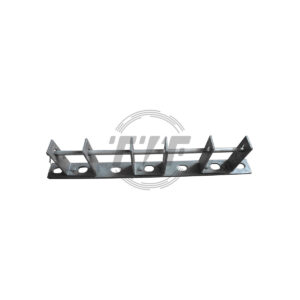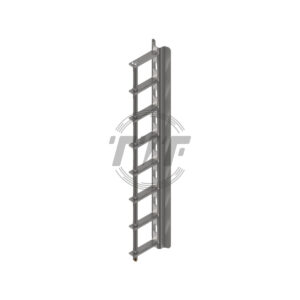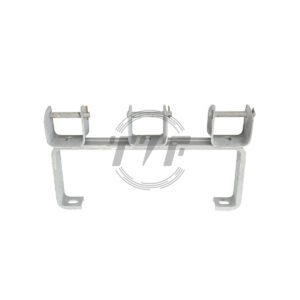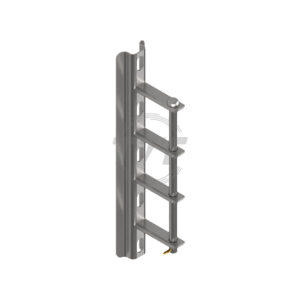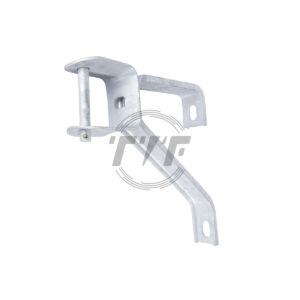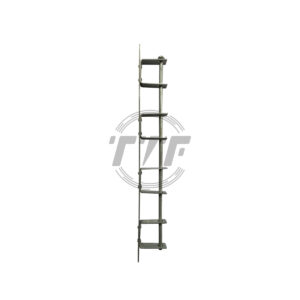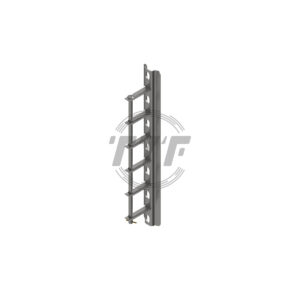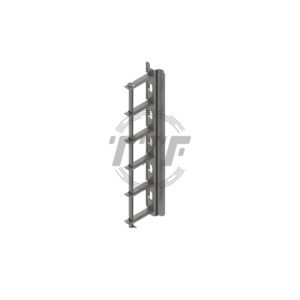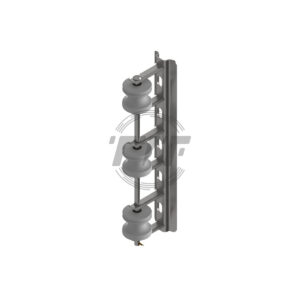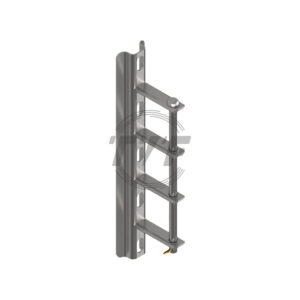Secondary Rack
Secondary racks organize multiple secondary wires to utility pole. They support the cables on an overhead pole line and tighten sagging conductors.
Showing all 11 results
-
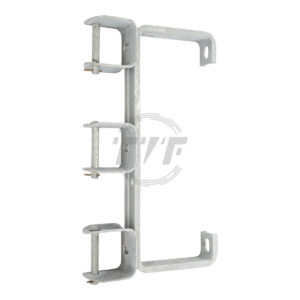
3-Wire Steel Secondary Bracket, 11-3/4in Offset
-

4-way Secondary Rack
-

Four-wire Secondary Rack
-

Galvanized Steel Secondary Bracket with 11-3/4 in Offset
-

Medium Duty 2-wire Secondary Rack with Extended Back
-

Secondary Bracket
-

Secondary Rack
-

Secondary Rack, 16 in Length
-

Three Wire Secondary Rack, Length: 21.75 in
-

Three Wire Secondary Rack, Length: 22.00 in
-

Two Wire Secondary Rack for Securing Secondary Wires
Read More
Secondary racks are a type of insulator cable support that incorporate a steel U channel at the base. Nuts and bolts secure the base to the utility pole. The secondary rack is galvanized and meets ASTM-123 standards. The secondary rack is designed to accommodate three to four conductors.The question then becomes, why is a secondary rack necessary? The answer lies in maximizing performance and efficiency when it comes to building an overhead infrastructure that requires high-quality accessories and materials. In these instances, a high-quality secondary rack comes in handy. As a result, when it comes to pole line infrastructures, a secondary rack is critical. Whether it’s for utility pole mounting, telephone pole line installation, or any other type of necessary infrastructure, high-quality secondary racks always improve functionality.Welding, drilling, riveting, and hot dip galvanizing are all steps in the manufacturing process. Our experts ensure that our secondary racks are manufactured using the most advanced techniques and technologies available to ensure the highest possible quality, functionality, reliability, and longevity, which is critical when it comes to telecommunications logistics and equipment.
Secondary Rack Purchasing Guide
Are you involved in the distribution of electrical power? A secondary rack is one of the power line accessories that you should consider purchasing.
This guide will teach you vital information about the secondary rack. At the conclusion of this article, you will be able to purchase the best secondary rack for power line in China.
What is a Secondary Rack?
A secondary rack is a spool insulator cable in the shape of a U with a steel base. The insulator’s design enables it to provide support on either side or inside the power line pole.
The rack features mounting holes that allow it to be attached to the pole using nuts and bolts. This secures them to the poles properly. Additionally, such secondary racks are simple to install, as the process is not labor-intensive.
The majority of secondary racks on the market can accommodate up to four conductors. However, you should consult the secondary manufacturer’s specifications to ensure that the device is not overloaded.
Secondary rack insulators are typically installed at strategic points along the mainline where power will be distributed to other subsidiary lines.
The secondary racks’ support for the conductors prevents sagging by tending to tighten the conductors against the pole.
Secondary Rack Components
To help you better understand what you’re about to purchase, the following are the primary components of a secondary rack:
Base: The base of a secondary rack serves as the bottom end. It is the part of the rack that attaches to the pole line or post and serves as a support for other rack components.
The base is made of steel metal, which is resistant to physical force and corrosion.
U-channel: This component serves as the primary insulator rack’s arm. It serves as a platform for stringing the powerline insulators.
Bolts and nuts: These are considered electrical spool holder accessories because they facilitate the attachment of the rack to the pole line , And they ensure the secondary rack’s stability.
Holes: These are the openings that bolts and nuts will pass through to secure the secondary rack to the pole.
Insulator: This component serves as the primary secondary nut, supporting the conductors. Additionally, insulators regulate the flow of electric current.
Cotton pin: The pin is used to secure the U-two channel’s ends.
Clevis pin/fastener: This type of fastener consists of a clevis pin and a tang. Additionally, it serves as a supporting actor.
Secondary Rack Types
Secondary racks come in a variety of styles and configurations. This enables them to meet a variety of power requirements.
Apart from design and configuration, secondary rack sizes vary.
You should be familiar with the following secondary rack types and configurations:
Secondary Rack 1 Spool
As the name suggests, this type of secondary rack has one spool. A spool is a cylindrical part that an axial hole and a ridge.
1 spool rack is mainly used for telecommunication lines where you don’t have to support many conductors.
Secondary Rack 2 Spool
This configuration is characterized by double spools. This allows it to effectively support parallel conductors.
Secondary Rack 3 Spool:
Like others, this secondary rack type has three spools.
Secondary Rack 4 Spool:
The rack has four spools hence is capable of supporting up to four conductors.
Secondary Racking Applications
Secondary racks are advantageous in infrastructures with poles and transmission cables due to their functions.Transmission lines, utility pole mountings, and telephone lines are all examples of this infrastructure.Although these are distinct infrastructures, they all share one characteristic.There is a pole and cables that connect the poles.
Additionally, it is critical to note that these projects are global in scope. Thus, you can purchase secondary racks in the Philippines, Africa, the Americas, or any other country in the world.All you need to do is determine the scope of your project and then purchase the appropriate secondary racks.
Installing a Secondary Rack in Steps
Whether you are technical or not, it is critical to understand the process of secondary rack installation.
The process of installing a secondary rack begins with marking the exact location of the rack.
Drill holes after marking the locations. Ascertain that the hole sizes correspond to the bolt and nut specifications.
Adjust the secondary rack to fit over the drilled holes and secure it with nuts and bolts. At this point, you can proceed to add additional rack components until the rack is complete and functional.
Verify the secondary rack’s stability on the pole and correct any errors.
That concludes the discussion! Nothing difficult. When installing a secondary rack, you are only required to follow the pole line safety measures.
Technical Specifications for Secondary Racks
Would you like to ensure that you end up with the appropriate secondary racks? It is critical that you pay close attention to the smallest details of this electrical spool holder.
The technical specifications will determine whether or not the rack is suitable for your project and will perform flawlessly.
A sample of the technical specifications is included in the table below.
Material is a critical specification. Ascertain that the rack is constructed of steel metal.
The dimension is another specification. You should be aware of the overall length, hole diameter, bolt size, and pin size, among others.
Are you looking for reputable secondary rack suppliers in the Philippines, Brazil, Kenya, or anywhere else in the world? We have the information you seek.
TTF designs, manufactures, and distributes high-quality secondary racks. We are a reputable manufacturer of secondary rack insulators in China.
Whether you’re interested in purchasing secondary racks online or in paying us a visit, begin by contacting us. We will assist you through the process of obtaining these overhead pole line accessories.

